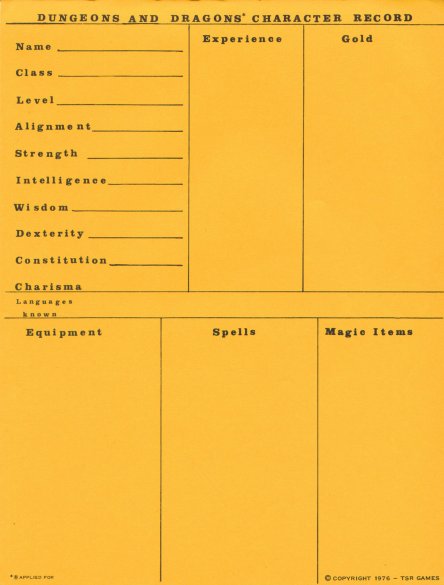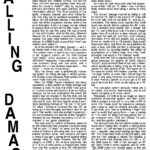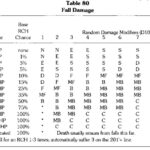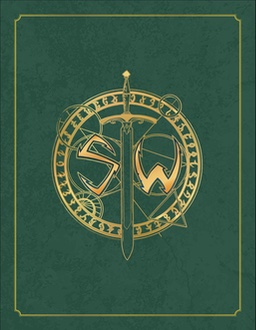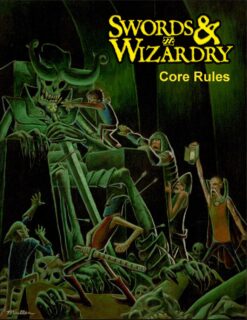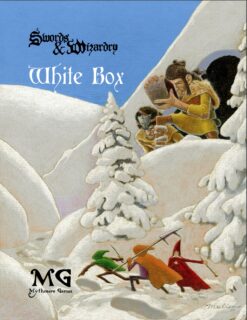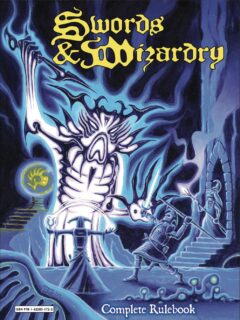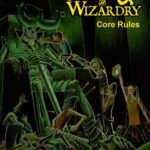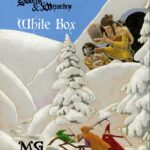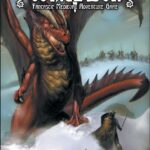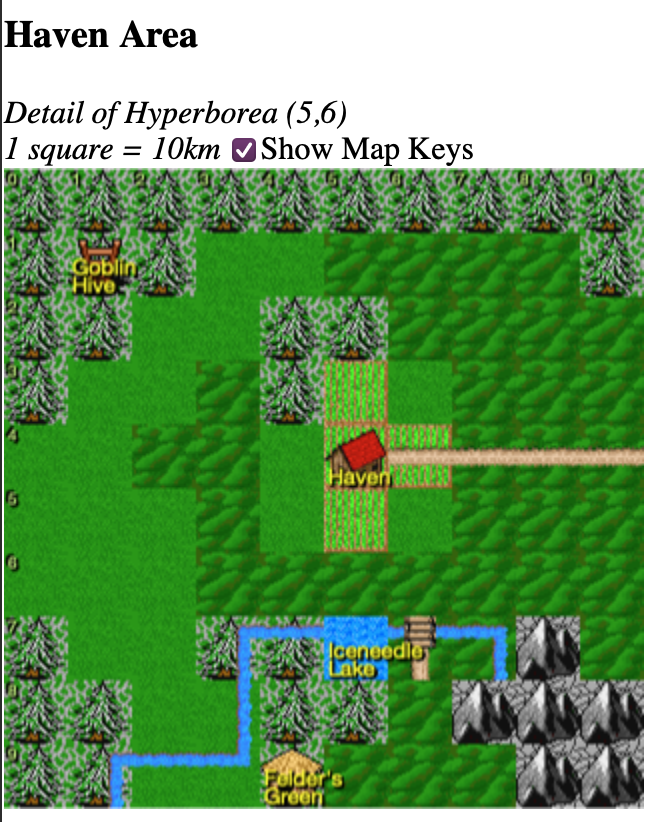Part II: 1973 Draft of Dungeons & Dragons
In which letters show Dave Arneson running Blackmoor for the Lake Geneva mob, and they set up their campign, with more areas taken from the Great Kingdom map. Interestingly the Grand Duchy of Urnst, south of Nyr Div lake, is full of dinosaurs and prehistoric mammals; Keoland, at this time much closer, not across the Wooly Bay and mountains, has Martian Thoats, Apts, etc. By the time of World of Greyhawk (1983), all traces of weird stuff has been erased, the encounter tables are all Knight, Pilgrim, Men, Men, Men; tho Blackmoor's table shows Gibberling, Quaggoth, Qullan, and Ice Troll encounters, at least.
Gygax's later implausible story in Dragon #7 (July 1977) is that Arneson "contributed" 18 pages of notes and ran "variant CHAINMAIL", while he heroically typed 300 manuscript pages.
I've gone over the draft D&D rules some when the Arneson v. Gygax court case document came out, and we have handwritten parts from Arneson, and typewritten draft from Gygax, which had this bon mot:
Introduction: This is where Gary editorializes and tells neat stories
as much as his little heart desires and if he wants to use the extra
pages. A rule book is a rule book not a novel.
—Dave Arneson
Stats are at this time GP (the rule doesn't say to x10, but the examples do), Intelligence, Cunning (Wisdom), Strength, Health, Appearance (Charisma). Cleric level titles are Acolyte, Friar (Adept), Village Priest, Priest (Vicar), Vicar (Curate), Curë (Bishop), Abbë (Lama), Patriarch. These have long been contentious, and obsolete, since no recent game has level titles, but the originals are MUCH better than the renamed ones. Lama? Magic-User they got right from the start, Fighter swapped Warrior (2) for Swordsman (3), and again I think the original is better.
Equipment lists "Zilidar" (200 GP) under Draft Horse, Small Thoat (400 GP), Large Thoat (1000 GP), Pegasus (2000), Hippogriff (3000 GP), Griffon[sic, "Gryphon"] (9000 GP), Roc (5000 GP), Thoat Saddle (25 GP), Hippogriff/Pegasus Saddle (15 GP), Roc/Griffon[sic] Saddle (50 GP), Thoat-Sized Saddle Bags (15 GP), Light Rations -1 on "Strength" after 1 week (2 GP/week).
Missing are the Iron Rations, Silver-Tipped Arrow, Mule, 10' Pole (!!!), Flask of Oil, and all the herbs & vampire-killing gear. Clearly wilderness adventures were the more significant part of the game at this time.
The preposterous prices for armor are there from the beginning: Leather (15 GP), Chain-Type[sic] Mail (25 GP), Plate Mail[sic] (50 GP), Helmet (5 GP), Shield (5 GP); latter two doubled in price. In more realistic historical records, Chain should be at least 75 GP, and Plate as much as 200-300 GP. Also all prices should be silver standard instead, but that's the least of our problems. Armor beyond Jack (not here represented) was for knights with a much higher economy than the peasantry, but everyone's rich in D&D.
NPCs are at this time "NON-REAL PLAYERS". Rules for hiring & retaining monsters are simpler, they abandon post as you spend time away from your castle. Henchmen can be hired for 100 GP/Level up to Level 3 Swordsman.
High-Level benefits are much more clearly explained, published OD&D simplified this to nonsense to save half a page. Notably:
When players reach the top of their class the referee should award
EP's at a rate of 1 for 3 to 1 for 10 or worse, depending on the
circumstances.
Thus resolving the high-Level Dwarf problem.
Many adventuring parts were later moved to Book III, notably the MONSTER DETERMINATION & LEVEL MATRIX which has killed so many with the 1/6 4 HD, 1/6 3 HD which can appear on dungeon Level 1. The monster tables are odd, Level 1 is just missing Skeletons & Spiders. Level 2 has extra Skeletons, Spiders, Giant Ants, Anti-Warrior (F 2, but struck out?). Level 3 has Thaumaturgists (M-U 5!), Anti-Warrior (F 2), Wight, and Giant Hogs, Toads, Crabs. I can't make sense of the original ecology, but published isn't better.
HITS AND RECOVERY: An actual explanation of damage, instead of a passing reference in Book III, and the healing rate is 2 HP/day, instead of 1/2 like published.
SCORING HITS: An actual system was presented, and completely cut from published.
Generally CHAINMAIL rules will apply as modified by the following:
Men vs. Men: If there are small numbers Fighting it will be most
interesting to use the Man-to-Man Melee Table. If large numbers are
fighting the Combat Table based on a troop ratio of 1:20 should be
used.Men vs. Fantasy Figures: It is suggested that the 1:20 Combat Tables
be used, with men scoring 1 hit point when they hit and fantasy
figures scoring hits equal to a die roll (1-6). Of course, some
fantasy figures cannot be hit by normal men, and no hit points will be
scored against them. (See the Fantasy vs. Fantasy section below.)Fantasy vs. Fantasy: Because of the vast number of fantastic creatures
and levels of men, a matrix to show hits is totally impractical (we
know because we tried, but with 70 or more categories it becomes too
unwieldy to handle). We therefore recommend that a system utilizing a
20-sided die (increments of 5%) be adopted. The basis for this will be
the assumption that a man will require e score of 19 (90%) or better
hit an opponent in plate mail and shield. Armor Classes will be given
in such a vey as to indicate their efficiency, viz, deduct their
number from 20, and the base number to hit them is obtained. Thus,
Plate mail and shield is "Class 2" and 2 - 20 = 18 [sic]. Each fantasy
figure is listed below, giving its base Armor Class (along with
various other data regarding it). Armer Class and what scores the
various levels of Fighting Men need to score a hit are:
Then a to-hit table which is literally just THACO 21 - Fighter Level; a 4th Level Hero would be THACO 17, AC 2 is 15+, AC 9 is 8+. Only levels 1-9 are shown, presuming you can follow a pattern of "-1 per Level". It does not have the weird gaps and level ranges for each class.
Magic-Users and Clerics have overly complex conversions, but essentially get competent at the Hero-1 level, Enchanter for M-U, Curë for Cleric.
As has been previously mentioned in interviews, Arneson increased defensive abilities by level, not so much the HP, but Gygax was doing both. Eventually this got deleted.
All men (Fighters, Magic—Users, & Clerics) add +1 to their Armor Class
when they attain the level of or equal to 4th level Fighting Man (Hero
and Abbë and Warlock in the other classes). 8th level Fighters
(Superheroes) add another +1 (as do 12th level Magic-Users and 10th
level Clerics). Only fighting men will continue to add to their
defensive capabilities, with +1's being awarded at the 12th and 16th
levels.
That certainly changes things. You can either be untouchable to greater HD monsters, or strip down to a lighter load and keep the same AC, a Superhero in Chain being as good as a mook in Plate.
Monster list (moved to Book II) and castle encounters (Book III) are apparently unchanged. Wilderness encounters are mostly the same, but annotations in here for Optional Dinosaur Swamps of results 9-12 Crocodiles to Snakes were not included in published, making that terrain very very dangerous.
PRIZE MATRIX: aka Treasure Types. Type A (Men) is fairly different, having prisoners 2/10 men for land & water, 1/20 men for desert, higher chances of loot it seems. Wow, Bandits & Brigands have 1d6 x 10 GP for each man. I'm fine with the 50%: 2-12000 GP in lair, but singles having 1/3 starting gold is crazy.
There are only Types A-H listed, published added Type I for Rocs only. Otherwise they seem similar. I should do some number-crunching, and also compare First Fantasy Campaign, see how the values line up.
Hrmn. Fighting experience is 100 EP x HD, and OSR loot GP is typically 1-4x fighting EP. So maybe the Bandits aren't as off as I think, I just don't see coins on each monster that often.
THE UPPER WORLD: An entire section on overworld adventuring not included in published, tho bits appear in OTHER WORLDS in Book III.
For example, there can be "gates" through which the players will enter
into the primordial past, the world of Barsoom, Lankhmar, or a
fantastical moon peopled by whatever creatures you desire.
Finally, there is the natural rivalry among players themselves. When
they attain the top rank of their various classes they must choose
domains in which to build their castles and live. This will result in
warfare between players, and usually such battles will provide the
most exciting table top play.
Endgame of Dungeons & Dragons is PVP mass warfare!
SPECIAL CONSTRUCTION AND EQUIPMENT COSTS: naturally follows, instead of just being a weird "why are there castle building costs?"
I will note that Arneson had a lot, A LOT, of Gor fanfic shit in First Fantasy Campaign, but it was mostly scrubbed from published D&D. But in this draft, there's still hireling costs for Female Slave (100-600 GP Initial Cost), Male Slave (200-400 GP), and Barony investments: Slave Dealing. It's not elaborated on, but Dave wrote this, Gary typed it up, and it made it thru multiple drafts before someone told them to stop.
MOVEMENT IN THE UPPER WORLD: Gives hexes per day (a wilderness "turn"), modified by the Outdoor Survival rules. Hope you have those handy! … The earlier reprint of 3 pages does not include this essential table, here it is from Outdoor Survival at Boardgame Geek
Some of the cut parts are so essential, I don't understand how D&D got published in this state. I'd previously assumed it was just "we knew this in play but didn't write it down", but they DID write it down.
And that brings me to the end of the first half of the draft. The rest is "Explanation of…"

